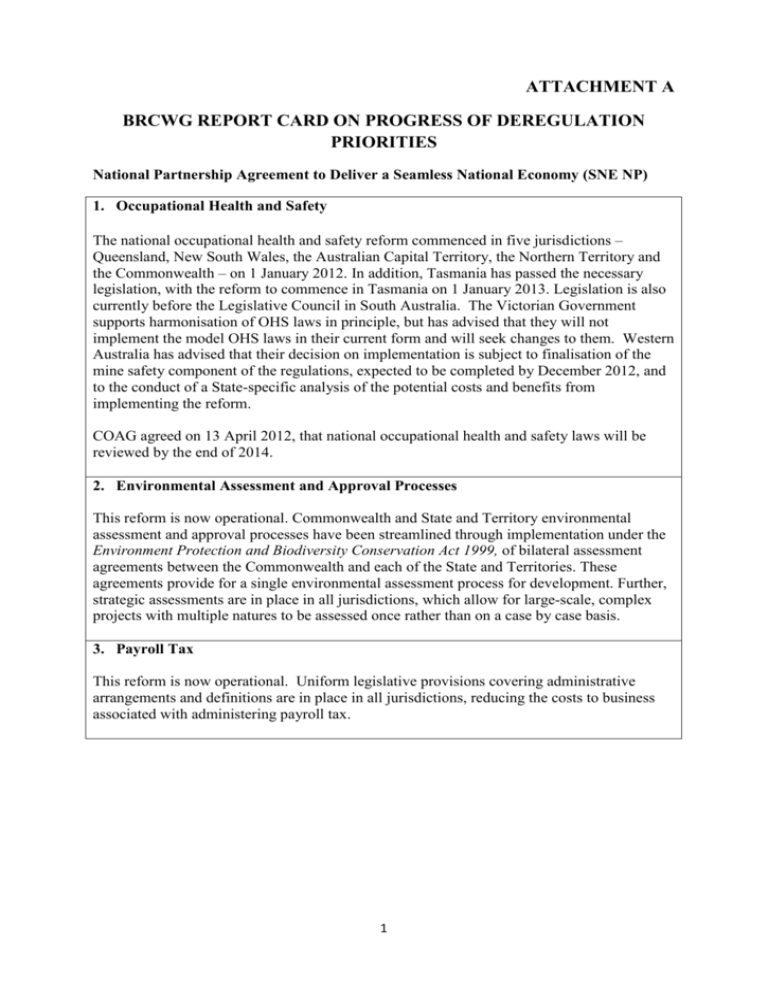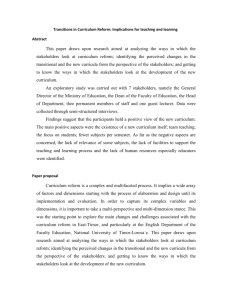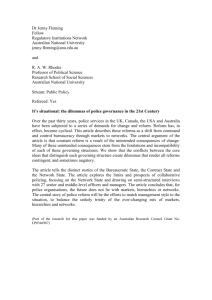BRCWG Report Card on Progress of Deregulation Priorities
advertisement

ATTACHMENT A BRCWG REPORT CARD ON PROGRESS OF DEREGULATION PRIORITIES National Partnership Agreement to Deliver a Seamless National Economy (SNE NP) 1. Occupational Health and Safety The national occupational health and safety reform commenced in five jurisdictions – Queensland, New South Wales, the Australian Capital Territory, the Northern Territory and the Commonwealth – on 1 January 2012. In addition, Tasmania has passed the necessary legislation, with the reform to commence in Tasmania on 1 January 2013. Legislation is also currently before the Legislative Council in South Australia. The Victorian Government supports harmonisation of OHS laws in principle, but has advised that they will not implement the model OHS laws in their current form and will seek changes to them. Western Australia has advised that their decision on implementation is subject to finalisation of the mine safety component of the regulations, expected to be completed by December 2012, and to the conduct of a State-specific analysis of the potential costs and benefits from implementing the reform. COAG agreed on 13 April 2012, that national occupational health and safety laws will be reviewed by the end of 2014. 2. Environmental Assessment and Approval Processes This reform is now operational. Commonwealth and State and Territory environmental assessment and approval processes have been streamlined through implementation under the Environment Protection and Biodiversity Conservation Act 1999, of bilateral assessment agreements between the Commonwealth and each of the State and Territories. These agreements provide for a single environmental assessment process for development. Further, strategic assessments are in place in all jurisdictions, which allow for large-scale, complex projects with multiple natures to be assessed once rather than on a case by case basis. 3. Payroll Tax This reform is now operational. Uniform legislative provisions covering administrative arrangements and definitions are in place in all jurisdictions, reducing the costs to business associated with administering payroll tax. 1 4. Licences of Tradespeople Progress continues to be made on establishing a national occupational licensing system to deliver benefits to business, consumers and the wider community through enhanced mobility of licensed trades between jurisdictions. All jurisdictions are working towards finalising consultation Regulation Impact Statements, to enable stakeholders to comment on the options for detailed licensing schemes for each of the four first tranche occupations. COAG agreed on 13 April 2012 to work towards agreement to the framing legislation and regulations for this reform by the end of 2012. COAG also agreed that, given the complexity of the reform, this reform will now commence from 2013. 5. Health Professional Registration and Accreditation This reform is now operational. This reform replaced over 85 health profession boards, governed by 66 Acts of Parliament, with a single national scheme. From 1 July 2010, the Australian Health Practitioner Regulation Agency (AHPRA) has been responsible for regulating chiropractors, dental care practitioners, medical practitioners, nurses and midwives, optometrists, osteopaths, pharmacists, physiotherapists, podiatrists and psychologists. The Productivity Commission’s Research Report on the Impacts of COAG Reforms: Business Regulation and VET, released in May 2012, estimates that the prospective benefits of this reform are $160 million per year. 6. Trade Measurement This reform is now operational. From 1 July 2010, a single national trade measurement system was established and is fully operational, replacing eight State and Territory trade measurement systems. Petrol pumps, retail scales and weighbridges are all measuring instruments that the public and business rely on every day to be accurate and fit-for-purpose. These measuring instruments, and the Licensees who service the instruments, are now regulated under one national regime meaning that businesses no longer have to deal with different regulators in each jurisdiction and different compliance and enforcement regimes. 7. Rail Safety This reform is now operational. Model legislation and associated regulations has been enacted in all relevant jurisdictions. This will facilitate more consistent safety outcomes for the rail industry and reduce the compliance burden on rail operators in meeting different rail safety regimes. The Productivity Commission’s Research Report on the Impacts of COAG Reforms: Business Regulation and VET, released in May 2012, estimates that the realised and prospective benefits of this reform are $15 million per year. 2 8. Consumer Policy Framework This reform is now operational. The Australian Consumer Law (ACL) commenced on 1 January 2011. The ACL provides for a national consumer protection framework, replacing provisions in at least 20 different and overlapping Commonwealth, State and Territory laws. The Productivity Commission’s Research Report on the Impacts of COAG Reforms: Business Regulation and VET, released in May 2012, estimates that the realised and prospective benefits of this reform are $880 million per year. Further information on the ACL can be accessed at http://www.consumerlaw.gov.au/ 9. Product Safety This reform is now operational. On 1 January 2011, a new national product safety regime commenced as part of the Australian Consumer Law. A single set of nationally consistent product safety laws now applies in all States and Territories, resulting in reduced compliance costs and improved certainty for businesses. Further information on the product safety reform can be accessed at www.productsafety.gov.au 10. National Regulation of Trustee Corporations This reform is now operational. A national regime for the licensing and supervision of trustee corporations commenced on 6 May 2010. The reform has put in place a national market for traditional trustee company services, replacing the eight separate State and Territory regimes which previously existed. The new regime increases consumer protection, cuts red tape for trustee companies conducting business in more than one jurisdiction, and lowers barriers to entry, promoting competition in the industry. 11, 12, and 13 Phase One National Consumer Credit Regulatory Regime Phase One of consumer credit reforms is now operational, with the establishment of a national regulatory framework for consumer protection regulation for mortgage broking, margin lending and non-deposit taking institutions on 1 July 2010. 3 14. Development Assessment (DA) Development assessment reforms that are now operational include: implementation of code based assessment for single residential dwellings that has been implemented in all States and Territories; national planning system principles that have been agreed and implemented by all States and Territories; and a framework that has been developed to measure the benefits of current and future planning reform initiatives and all jurisdictions have agreed to use this methodology to assess the benefits of any new national reform initiatives. The Housing Supply and Affordability Reform (HSAR) Working Party of the Standing Council for Federal Financial Relations has completed a review of housing supply and government policies that may act as barriers to supply or that stimulate demand for housing, and has reported these findings to COAG. With the completion of this review, COAG agreed that this reform is complete. 15. National Construction Code (NCC) All jurisdictions have signed the NCC Intergovernmental Agreement containing the governance and financial arrangements for the Australian Building Codes Board as the governing body. The NCC has been fully adopted in five jurisdictions (Australian Capital Territory, South Australia, Tasmania, Victoria and Queensland). The remaining three jurisdictions (New South Wales, Northern Territory and Western Australia) have adopted the building aspects of the NCC and are working towards adoption of the plumbing aspects prior to the commencement milestone of October 2012. The Productivity Commission’s Research Report on the Impacts of COAG Reforms: Business Regulation and VET, released May 2012, estimates that the prospective benefits of this reform are $1.05 billion per year. 16. Chemicals and plastics regulation Progress continues to be made in implementing the 30 chemicals and plastics regulation reforms. 14 Reforms remain to be completed, with most reforms expected to be complete by the end of 2012. Enhanced reporting by the Standing Committee on Chemicals (SCOC) continues to help drive chemicals and plastics regulation reform momentum and facilitate scrutiny by stakeholders. SCOC Reports on reform progress and the SCOC Review are publicly available and can be found at: http://www.innovation.gov.au/INDUSTRY/CHEMICALSANDPLASTICS/SCOC/Pages/def ault.aspx 4 17. Registering Business Names This reform was delivered in line with the agreed milestones, with the release of the National Business Names Registration Service and the Australian Business Register on 28 May 2012. All states and territories have passed legislation to enable their adoption/referral and transition to the new system. Refinements to the business names system and a number of supporting elements are continuing to be implemented. This reform establishes a national system for business names registration, enabling businesses to register for business names and Australian Business Numbers in one place. 18. Personal Property Securities (PPS) COAG welcomes the commencement of this reform. The Personal Property Securities Register commenced operation on 30 January 2012. The reform establishes a single national PPS law and PPS Register that will: increase certainty for those creating, dealing with and enforcing secured lending arrangements; increase competition among secured finance providers; and assist business to secure finance against property. 19. Standard Business Reporting (SBR) This reform is now operational. SBR has been operational since 1 July 2010, offering Australian businesses, accountants, bookkeepers, tax agents and payroll professionals a quicker and simpler way to complete and lodge reports for government. More information is available at www.sbr.gov.au The Productivity Commission’s Research Report on the Impacts of COAG Reforms: Business Regulation and VET, released in May 2012, estimates that the realised and prospective benefits of this reform are $60 million per year. 20. Food regulation This reform is now operational. The centralised interpretive advice function in Food Standards Australia New Zealand commenced on 1 July 2011. This function will enable a nationally consistent approach to the way in which food standards are interpreted and enforced by jurisdictions. 21. National Mine Safety Framework National mine safety reform is continuing to progress, with a nationally consistent mine safety regime expected to be operational by December 2012. Work on the model Work Health Safety (WHS) Regulations and Codes of Practice for mining is progressing as a matter of priority. 5 22. E-conveyancing Progress is being made toward the establishment of a National E-conveyancing System (NECS). An intergovernmental agreement to provide a governance framework for the reform has been signed by majority of jurisdictions, with the final jurisdiction expected to sign shortly. A draft Electronic Conveyancing National Law was released for public consultation by the Australian Registrars National Electronic Conveyancing Council. A draft Regulation Impact Statement has been prepared and will be released for consultation shortly. Further information on the reform can be found at http://www.nationaleconveyancing.com.au/ 23. Oil and Gas Regulation This reform is progressing with a number of milestones recently completed, including: The National Electronic Approvals Tracking System (NEATS) was publicly released on 7 May 2012 and provides an electronic title register, approvals tracking and interactive map. All guidelines under the Offshore Petroleum and Greenhouse Gas Storage Act 2006 have been amended to reflect the regulatory reforms and provide timelines for Joint Authority decisions. 24. Maritime Safety COAG signed the intergovernmental agreement to establish the Australian Maritime Safety Authority as the single national regulator for maritime safety in August 2011. COAG is committed to the implementation of this important reform, which will establish a nationally consistent approach to maritime safety standards and a single national maritime safety regulator by January 2013. 25. Wine Labelling Wine labelling reforms have been delivered. All States and Territories have harmonised their wine labelling requirements with effect from 1 July 2009. Australian wine producers now have greater choice in how they meet labelling requirements for standard sized wine containers destined for domestic and export markets. The Productivity Commission’s Research Report on the Impacts of COAG Reforms: Business Regulation and VET, released in May 2012, estimates that the realised and prospective benefits of this reform are $29 million per year. 26. Directors’ Liability BRCWG reported to COAG in July 2012 on the outcomes of jurisdictions’ re-audits of legislation against new Guidelines, along with advice on proposed amendments to deliver a nationally consistent and principles-based approach to the imposition of personal criminal liability for directors. Jurisdictions will introduce amending legislation in the second half of 2012. 6 27. Phase Two Consumer Credit reforms Jurisdictions are continuing to settle the scope and process for implementing the final stage of the National Credit Reforms (Phase 2, Part 2), which includes consideration of the need for national regulation of areas such as credit for investment purposes and for small businesses. Jurisdictions are working to agree the legislation and legislative approach in the second half of 2012. 7







